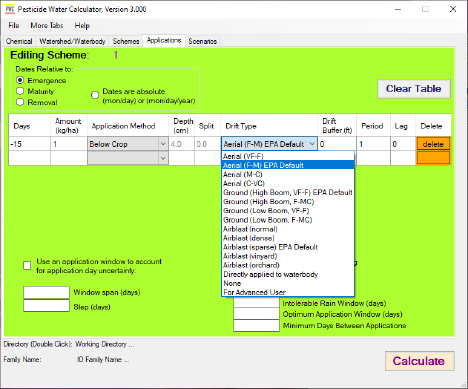Regulatory Issues Management

Addressing special regulatory concerns requires expertise in various fields, including endangered species assessment, endocrine disruption, product safety, and mixture impacts. Waterborne has these expertise... and more.
![]()
We have the expertise and experience
Addressing special regulatory concerns
We are ready to assist you in developing a strategy to meet your unique needs, whether it is providing support for your established processes or helping you determine where to start. Our breadth of expertise offers a combination unmatched by our competitors. We integrate your ideas with our experiences to develop a strategy, work plan and product that we can all be proud of. We understand from experience that some of the best solutions come from engaging people with diverse expertise. We bring our talents together to maximize our ability to serve you. Time, resources and expectations will be at the forefront of each project so that we can come together to deliver our agreed-upon work products.

Do you have questions about our Regulatory Issues Management work?
Contact Waterborne's Regulatory Issues Management lead, Nathan Snyder, at snydern@waterborne-env.com.
Chamber Workforce Programs
Our Regulatory Issues Management Work
Endocrine Disruption
Our ecotoxicology team understands the need to provide our clients with comprehensive and expert consultation to support the requirement of the Endocrine Disruptor Screening Program (EDSP), as well as other regulatory guidelines where endocrine activity is part of the environmental assessment process.
We’re equipped with a unique collective experience from industry, academia, contract research laboratories and consulting. We also have team members who have extensive EDSP experience in method development, validation and study conduct, mode of action (MOA) evaluation, other scientifically relevant information (OSRI) and weight of evidence (WoE) development. Whatever your need, our professionals have the EDSP proficiency, including development of laboratory biomarkers for endocrine disruption and computational toxicology, to help your company succeed.
Waterborne and ToxStrategies, Inc. have teamed up to provide the solutions our clients need to meet the challenges of the full range of EDSP testing orders and WoE assessments. Professionals at ToxStrategies have years of practice in the development and conduct of in-vitro and in-vivo mammalian assays. The collaboration between Waterborne and ToxStrategies offers our clients a comprehensive consulting team for all Tier 1 assays and future Tier 2 testing requirements, as well as OSRI and WoE development.
Product Safety
From the consumer products we all use every day to the medicines we need to stay healthy to the components in the food we eat, we know product safety is paramount to your organization. That’s why we work hand-in-hand with your company’s human health and environmental safety team to address questions that are unique and important to your philosophy around human health and environmental protection.
Your human health and environmental safety team is expected to ensure your personal care products do not cause adverse effects to the consumer or in the environment. Waterborne’s expert team can support activities such as safety assessments, environmental exposure modeling, in-situ field data collection, mammalian pre-clinical or ecotoxicological study management to uphold human and environmental health in both established markets as well as emerging markets where data availability, such as product usage or local connectivity to wastewater treatment, may be a challenge.
Mixtures
In the environment, chemicals and other stressors do not occur in isolation. They are often present with an assortment of other chemical and non-chemical stressors. Understanding the potential effect these combined stressors may have on aquatic life is difficult to uncover. Equally difficult is to predict the places & times combined stressors may have an adverse effect in order to potentially reduce these occurrences. Retrospectively, comparing existing ecological assemblages present at a test location compared to reference conditions allows for a measure of ecological impact. Apportioning stressors to these impacts can be a challenge. Waterborne has experience in understanding and predicting environmental mixtures, their potential effects, and how the diverse combination of these factors can be combined in order to protect ecological health.
Mixture Toxicity
From developing a conceptual framework for your mixture question to designing ecotoxicological studies to assess mixture effects, Waterborne has the expertise to help answer your mixture questions. While a mixture may impact aquatic life, often the toxicity is linked to a select few chemicals in the mixture. There are several scientific strategies (concentration-addition, potency factors, etc) that can be used to address the complex question of mixtures and the strategy used is heavily dependent on the question at hand. We ensure a scientifically sound data package when Waterborne’s ecotoxicological mixture expertise is paired with our spatial analysis and modelling capabilities.
When developing exposure strategies, laboratory studies conducted with complex mixtures must be thoughtfully designed. Waterborne scientists have practical experience evaluating difficult-to test mixtures and multi-component formulations with numerous analytes. Custom-tailored dosing methodologies can be developed to maximize solubility in aqueous matrices for exposure. Assessments can also be made using component-specific evaluations, from which toxicity profiles can be developed from information on identified components with known modes of action.
Environmental Mixtures
Chemicals present in environmental mixtures come from a variety of sources:
- Point source discharges such as wastewater treatment plants, storm water, or industrial discharges
- Non-point sources such as agriculture, livestock production, diffuse runoff from hard surfaces containing petroleum or metal products such as roadways and parking lots
- Other stressors, such as sediment, can originate from new residential or commercial construction
Waterborne’s ability to apply our environmental modeling capabilities across multiple sectors makes us well-suited to take an active role in estimating environmental mixtures.
Waterborne is part of a consortium of companies and institutes who are examining the relative impact of stress factors, including chemical mixtures, to river systems by developing and using statistical and eco-epidemiological methodologies.
Prospective risk assessments of chemicals may include the use of bioavailability models, Species Sensitivity Distributions and mixture-effect modeling to estimate the proportion of species potentially affected by chemical mixtures. To test such approaches, it is imperative that data-sets be obtained that contain a range of prospective risks from chemicals and other stressors which can be matched to documented biological impacts using a geographic information system.
Since species assemblages can be affected by factors other than chemicals, an eco-epidemiological analysis of chemical risks needs to take into account the myriad of potential factors that may affect biological community status. These factors include in-stream habitat quality, eco-region, river size, and water chemistry. Characteristics of biological assemblage (traits) may also be helpful in diagnosing potential causation of impacts.








